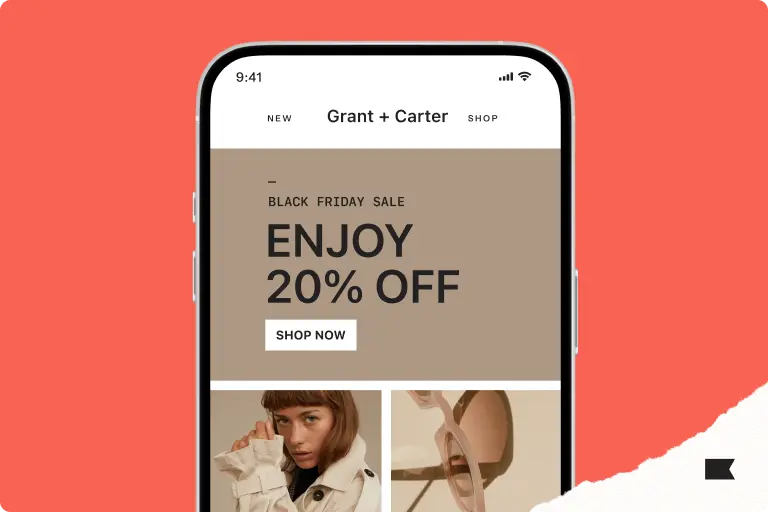
Combine the power of SMS and email marketing to boost growth
Email may be the bread and butter of your owned marketing strategy, but it can no longer act alone.
According to Klaviyo’s 2025 future of consumer marketing report, consumers primarily make purchases on mobile, with in-store as a close second. With the exception of the hotel industry, shopping on desktop has dropped to the third most popular way to shop across all verticals.
Our research also found that 74% of consumers now expect personalised experiences from brands—and part of that means meeting people where they’re at on their preferred channels.
Yes, many people still prefer email. But SMS has grown leaps and bounds as a revenue driver in the last few years. According to Klaviyo’s SMS consumer research with Recharge, 86% of consumers made two or more purchases via SMS in 2024—up from 55% in 2022.
But before you get too excited, there are some important nuances to understand about what makes sense for email and what makes sense for SMS. Knowing how these channels are different—and how they complement each other—is really how brands can see revenue growth from this lucrative combination.
Why does combining SMS and email marketing matter?
Email has the patience to build deep relationships with a large number of people, whereas SMS swoops in to communicate urgent matters with a highly engaged subset of your audience. Together, they create one experience that serves multiple consumer needs.
But one of the most important things to remember about this winning combination is that both channels need to be drawing from the same customer data so that your audience doesn’t feel any real inconsistencies between these channels, despite their differences.
With a B2C CRM syncing data in real time, every experience you deliver is highly personalised and relevant to your customers. That means showing them their new favourite product in their preferred channel—email, SMS, or mobile push—at the right time, and personalising cross-sell messages with AI-powered product recommendations based on past purchases.
With that in mind, here’s how each channel can help you create the personalised, yet consistent experiences consumers have come to expect.
SMS marketing benefits: speeding up time to purchase with immediate action
- Faster time to purchase: According to Klaviyo’s SMS consumer trends report, 65% of people who made an SMS purchase in 2024 said they ended up buying an item earlier than they planned because of a promotional text message.
- Direct line to your most engaged subscribers: Subscribers who gave your brand a phone number want to hear from you the most. Your SMS audience may be smaller than your email list, but it’s potentially more lucrative per recipient.
- Immediate action through concise messaging: The character limit in SMS encourages brevity, which can lead to clearer and more impactful messages—great for flash sales or quick reminders that require immediate action.
- Less competition in the inbox: SMS still stands out, unlike emails that can get lost in busy inboxes.
Email marketing benefits: high return on investment with in-depth content
- High ROI: Email marketing makes £38 for every £1 spent, according to Statistica. It continues to be a cost-effective channel that sees real returns.
- In-depth brand building: Emails can convey more detailed information—great for newsletters, product descriptions, and brand storytelling.
- Rich content capabilities: Email marketing lets you include multimedia elements, like images and GIFs, for visually appealing content. You can send images with MMS, but note that those text messages cost more to send.
Most ecommerce brands find that using both SMS and email marketing works best. It’s all about finding the right balance and playing to the strengths of each tool.
When to use SMS vs. email—and how to combine them
| SMS | |||
| Product launches | Early access | ✅ | |
| General announcement | ✅ | ✅ | |
| Sales and discounts | Multi-day sales | ✅ | ✅ |
| Flash sales | ✅ | ||
| Personal discount codes | ✅ | ✅ | |
| Location-specific events | Pop-up or limited-time events | ✅ | |
| All-day or longer events | ✅ | ✅ | |
| Back-in-stock alerts | ✅ | ||
| Delivery updates | ✅ | ✅ | |
| Surveys and product feedback | ✅ | ✅ | |
| Educational content | ✅ | ||
| Newsletters | ✅ | ||
| Brand announcements | ✅ | ||
SMS: for messages that need to be seen quickly
Use a text message when you want to make sure a message is seen quickly. For example, send promotional text messages for:
- VIP early access to new products
- Flash sales
- Pop-up events
- Back-in-stock alerts
- Survey and feedback requests
- Personal discount codes
You’ll also want to make good use of SMS for transactional messages like:
- Order confirmations
- Shipping and delivery notifications
- Customer service interactions
💡SMS and email marketing tip: Conversational SMS is increasingly becoming a preferred channel for customer service, depending on the inquiry. So don’t sleep on the channel for customer retention, either.
Email: for longer, more in-depth messages
Use an email for longer-form content that can build deeper relationships. For example, send promotional emails like:
- General access to product launches and sales
- Personal discount codes
- Company announcements
- Behind-the-scenes brand stories
- Newsletters
- Educational content
And, similar to SMS, use email to send transactional messages like:
- Order confirmations
- Shipping and delivery notifications
- Customer service interactions
💡SMS and email marketing tip: Send any important messages you send by SMS via email to the rest of your subscribers. The only exceptions are if you’re sending an exclusive offer to SMS subscribers or asking for feedback from this group in particular.
When to use email and SMS together
Timing is one of the most important considerations when you’re sending similar messages via email and SMS. When you’re combining email and SMS for the same subscribers, you’ll need to choreograph a dance between those two channels so they’re working for each other rather than against each other.
For example, let’s say you have a big sale. You could send a detailed email a few days before that explains all the details of each deal. Then, on the day of the sale, you can send a quick SMS reminder that’s personalised to each person’s shopping habits. The email gives all the info, and the text gives that final, personalised nudge.
For transactional updates, SMS is the superior option. People love getting a quick text letting them know their order has shipped or is out for delivery. It’s instant and won’t get missed in their email inbox.
You can also use multi-channel automations to nudge someone toward a purchase. For example, when someone abandons their cart, you could send a gentle email reminder first. If they don’t bite, follow up with a text message offering a small discount if they complete the purchase.
The key is to think about your customer’s journey with your brand:
- Where are they in their relationship with your brand?
- What kind of information do they need right now?
- Is it urgent or can it wait?
Answer these questions, and you’ll know whether to send an email or a text. It’s not about bombarding people with messages on every channel. It’s about reaching out at the right time, on the right channel, with the right message.
Stay on the right side of the law: email and SMS compliance
In the United Kingdom, email and SMS marketing are subject to specific legal requirements under the Privacy and Electronic Communications Regulations (PECR) and the UK General Data Protection Regulation (UK GDPR), and in the European Union – the EU’s General Data Protection Regulation (EU GDPR).
Under these laws, businesses must not use false or misleading sender information (it must be clear the message is from your organisation), and your subject lines or SMS content must accurately represent the purpose of your communication.
For both email and SMS marketing, individuals must be given a clear and easy way to opt out at any time. You should always include an unsubscribe link in your emails, and for SMS campaigns, inform recipients they can reply “STOP” to opt out. Opt-out requests must be actioned promptly, usually within 28 days under PECR guidance, although best practice suggests processing these as soon as possible.
When obtaining consent to send marketing emails or SMS messages, it is important to note that consent must be explicit and informed, and should be obtained separately for each channel. Consent for email does not equate to consent for SMS, and vice versa. A robust approach such as double opt-in is strongly recommended to ensure individuals genuinely agree to receive marketing communications.
💡 Tip for effective SMS and email marketing:
Consider using tools like Klaviyo’s Smart Opt-In for SMS, which can send subscribers a code to verify and autofill their details at sign-up, supporting strong consent processes.
In addition to PECR, organisations must also adhere to wider data protection legislation, including the UK GDPR and EU GDPR, which place strict requirements on how you collect, process, store, and use personal data for marketing purposes. If you target individuals in different European countries or within the UK, be aware that local regulators (such as the UK Information Commissioner’s Office, ICO) may interpret and enforce these rules slightly differently. In some cases, additional national laws may impose further obligations.
It is essential to understand the legal requirements in all relevant jurisdictions where your contacts reside, particularly as regulations continue to evolve.
How emails compare to text messages: the numbers
Our SMS consumer research found that most people prefer receiving emails over SMS for major touchpoints, including order confirmations, coupon and promo codes, and even low inventory alerts.

Source: Klaviyo – SMS Consumer Report – European version
European consumers are most keen to receive texts about:
- Shipping and delivery confirmations: 29%
- Birthday deals 24%
- Order confirmations: 21%
- Coupons and promotional codes: 22%
- Back-in-stock notifications 21%
As for emails, they prefer to receive:
- Order confirmation: 53%
- Coupons and promo codes: 48%
- Loyalty program offers and benefits: 48%
- Subscription updates 48%
- Promotion/sales announcements: 45%
SMS marketing has become a fundamental channel for communicating with consumers in Europe, for essential transactional SMS updates, and for rewarding your most loyal customers.
Have concerns about annoying your SMS subscribers? Don’t
When it comes to SMS marketing, many ecommerce brands worry about how much to send. The secret is to be respectful, relevant, and mindful of how often you reach out.
Our latest SMS consumer report found that 74% of European shoppers made a purchase after receiving an text from a brand (compared to 70% in America)
To alleviate your worries, always get clear permission before sending any texts. Once you have that, prioritise quality over quantity. Instead of flooding customers with messages every day, reserve SMS for important updates or time-sensitive offers. Each message should provide real value, so keep it clear and to the point and include a strong call to action (CTA).
Timing is also crucial. Avoid sending texts too early in the morning or late at night. As a side note, our research found that European consumers are more likely to purchase from a text message in the evening (usually while watching TV and scrolling on their phones).

Source: Klaviyo – SMS Consumer Report – European version
Ultimately, your goal should be to enhance the customer experience through personalisation. Use customer data to segment your audience based on their behaviour and preferences, and you’ll be able to send them messages that are relevant to them (and won’t annoy them!).
10 creative ways to combine SMS and email marketing campaigns
- Welcome series: If someone signs up for both email and SMS on a multi-step form, start with a welcome email providing detailed information about your brand, followed by a quick SMS with a custom discount code.
- Abandoned cart recovery: Send an initial email reminder about the abandoned cart, then follow up with a text message offering a limited-time discount within 24–48 hours if they haven’t made the purchase.
- Product launch: Give your SMS subscribers a sneak peek, then launch your product via email to other relevant audience segments.
- Flash sale: Send an email with sale details in advance, then use SMS for last-minute reminders as the sale is about to start or end.
- Post-purchase: Send an order confirmation email, followed by SMS updates on shipping and delivery status.
- Re-engagement: Start with a “we miss you” email offering an exclusive discount for returning customers, then send a follow-up SMS if the recipient doesn’t make a purchase within 48 hours.
- Event promotion: Send an email invitation with event details, then use SMS for day-of reminders or last-minute changes.
- Loyalty program: Use email for detailed program information and points updates, with SMS for quick notifications about bonus point opportunities.
- Birthday campaigns: Send a birthday email with a special offer, followed by an SMS reminder if the offer hasn’t been redeemed close to expiration.
- Seasonal campaigns: Start with themed emails showcasing seasonal products, then use SMS for time-sensitive promotions during peak shopping days.
Brand spotlight: Coffee Beanery leaves Postscript to consolidate channels in Klaviyo B2C CRM
When Coffee Beanery ran email marketing through Klaviyo and SMS marketing through Postscript, they struggled with sending too many messages—often sending emails and texts at the same time. But repeat purchases are essential to Coffee Beanery’s business. They couldn’t afford to alienate subscribers.
Switching to Klaviyo B2C CRM has empowered the team to drive sign-ups and recurring revenue while avoiding unsubscribes. “Using Klaviyo for email and SMS, you can align customer communications and not overcommunicate,” explains Ben Zettler, founder of Zettler Digital, Coffee Beanery’s marketing agency.
How? First, they use multi-step sign-up forms to collect preference data on their preferred product categories. Then, they use that preference data in combination with purchase history data to create interest-based segments and message people about what they’re most interested in.
Finally, they use hybrid email and SMS automations for abandonment messaging, shipping alerts, and replenishment reminders to ensure email and SMS go out in a logical, staggered sequence to dual subscribers. All of the above contributed to 12% YoY growth in flow revenue in Q4 2024.
Get started with a platform that combines SMS and email marketing
Combining SMS and email marketing can really improve how your brand communicates and get great results. Using both together helps you connect better with your customers and encourages them to take action—and it all starts with the right platform.
Klaviyo B2C CRM—the CRM built for B2C brands—consolidates email and SMS by centralising the data they pull from. This is how B2C brands can create personalised experiences for thousands or even millions of subscribers at scale.
Let’s say someone clicked on an email, browsed a certain product page a few times within a week, then abandoned check-out after sharing their phone number. Klaviyo B2C CRM centralises all the information you’ve learned about this customer’s journey into one place—and makes it easy to send that customer a flash sale SMS for the product they engaged with because of an email.
Klaviyo uses built-in AI and sophisticated automation to create a well-oiled SMS and email marketing machine. You can set up smart campaigns that know when to send an email and when a text might be better, all based on what your customers are doing. And, with a 360-degree unified view of your customers, you can make sure you’re only sending stuff they want to see.
Here are some of the ways Klaviyo can enhance your SMS and email marketing campaigns:
- Deeper personalisation: Boost engagement and reveal powerful insights with all your data in Klaviyo’s built-in customer data platform.
- 350+ pre-built integrations: Centralise your data for easy activation with a large ecosystem of integrations and flexible APIs.
- Sophisticated segmentation: Build super-specific audience segments in seconds with any data, from any source, across all time.
- Omnichannel momentum: Keep revenue flowing by automating email, SMS, mobile push, reviews, and any other channels you integrate. Send super-relevant messages at key moments with flows, and boost revenue by delivering campaigns via the best channel for each recipient.
- Better performance: Outdo yourself day after day with Klaviyo AI’s always-on insights and optimisations. Hone experiences quickly with hands-off testing for forms and campaign personalisation.
- Ease of use: Equip your team to make fast progress with 160+ pre-built email templates, 80+ pre-built flows, and many more intuitive features—no coding required.

Related content

Migrating to Klaviyo? Get expert insights on timing, tools, and tips to maximize your impact before Black Friday & Cyber Monday.

Explore Black Friday Cyber Monday email examples from top brands like Beyond Yoga and Twinings. Learn what worked, get expert tips, and see their successful results.

Learn more about the best time to send marketing emails. Pinpoint the optimal time to capture user attention to boost engagement and ROI.